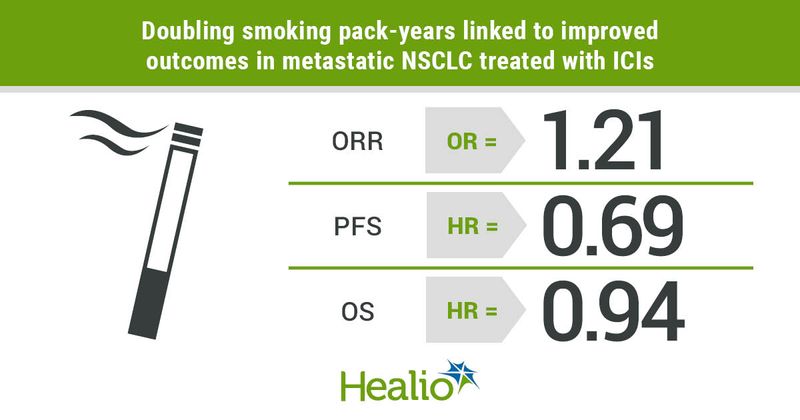Smoking exposure may predict immune checkpoint inhibitor efficacy in advanced NSCLC
Increased smoking exposure appeared associated with improved clinical outcomes in metastatic non-small cell lung cancer treated with immune checkpoint inhibitor monotherapy, according to a study in Journal of the National Cancer Institute.
Researchers observed the association independent of PD-L1 tumor proportion score.

“This study provides important implications that smoking history may serve as an independent surrogate for TMB [tumor mutation burden] in ICI [immune checkpoint inhibitor] efficacy in advanced NSCLC,” David C. Christiani, MD, MPH, MS, Elkan Blount professor of environmental genetics and professor of medicine at Harvard Medical School, director of the Harvard Education and Research Center for Occupational Safety and Health, and physician in the pulmonary and critical care division in the department of medicine at Massachusetts General Hospital, and colleagues wrote.
“Improved clinical response and outcomes to ICI monotherapy with increased tobacco exposure are statistically significantly mediated by TMB, giving rise to a more robust immune response,” Christiani and colleagues continued. “A detailed smoking history should be collected in future clinical practice to make prompt clinical decisions and to enhance the proportion of patients who may benefit from ICIs.”
Consistent and easily obtainable predictors of ICI efficacy have been difficult to identify, according to the researchers, and tobacco smoking — the leading cause of lung cancer — has been consistently associated with a higher TMB and increased response to immunotherapy. However, previous studies failed to sufficiently capture quantitative smoking exposure, limiting its potential as a predictor for ICI efficacy, they added.
The analysis included 644 patients with advanced NSCLC treated with ICI monotherapy between April 2013 and September 2020 at Dana-Farber Cancer Institute and Brigham and Women’s Hospital. Researchers categorized the patients into three groups: never smokers (n = 105; median age, 63 years; 57.1% women), former smokers (n = 375; median age, 69 years; 55.2% women; median pack-years, 28) and current smokers (n = 164; median age, 63 years; 53% women; median pack-years, 40). Current smokers had the highest median TMB (12.2 mut/Mb), followed by former smokers (9.9 mut/Mb) and never smokers (7.6 mut/Mb).
In addition to smoking history and TMB by targeted next-generation sequencing, Christiani and colleagues prospectively collected clinicopathological characteristics and PD-L1 tumor proportion score by immunohistochemistry.
After adjusting for other potential predictors, researchers evaluated the association of smoking history with clinical outcomes of ICI monotherapy. They used RECIST version 1.1 to determine objective response rate and PFS, and defined OS as the start of ICI therapy to last contact or death, whichever occurred first.
Results of multivariable analysis, after adjustment for clinicopathological characteristics such as PD-L1 score, showed a significant association of smoking status with higher ORR (former vs. never smokers, OR = 2.07; 95% CI, 1.08-4.25; current vs. never smokers, OR = 3.04; 95% CI< 1.52-6.47). Never smokers had significantly shorter PFS (2.07 months) than former smokers (3.65 months; HR = 0.74; 95% CI, 0.59-0.93) and current smokers (3.68 months; HR = 0.6; 95% CI, 0.46-0.79), and numerically shorter OS (9.9 months vs. 12.9 months vs. 13.2 months).
Adjusted multivariable analyses suggested doubling the amount of smoking pack-years was statistically significantly associated with improved clinical outcomes among patients treated with ICI monotherapy (OR for ORR = 1.21; 95% CI, 1.09-1.36; HR for PFS = 0.92; 95% CI, 0.88-0.95; HR for OS = 0.94; 95% CI, 0.9-0.99).
Because approximately 30% of the patients did not have PD-L1 tumor proportion score values, researchers maximized accuracy with the construction and validation of predictive models. Models that incorporated smoking pack-years with PD-L1 tumor proportion score achieved similar performance as those that used PD-L1 tumor proportion score and TMB, providing clinical evidence that smoking pack-years can be used as a surrogate for TMB, Christiani and colleagues wrote.
“Pack-years may serve as a consistent and readily obtainable surrogate of ICI efficacy when TMB is not available to inform prompt clinical decisions and allow more patients to benefit from ICIs,” researchers concluded.

